Do you need exercises for muscle and joint pain ? Do you know the RICE system to relieve muscle tension? We would like to explain to you why muscle pain occurs and what we can do if we suffer from this. Several things can cause muscle pain (this is also called myalgia); for example, trauma, infections and diseases. Muscle pain can be temporary or chronic. Delayed onset soreness (DOMS) occurs after exercise. Let's look at some measures you can take to prevent and control muscle pain and the conditions that cause it. Learn to soothe muscle pain in the back, neck, arms, legs, lower back, etc.
Why do we suffer pain in the muscles of the body?
Muscle pain is called myalgia. Pain in the body is the sign of an injury, infection , illness or other health problem. You may feel a deep, constant pain or an occasional sharp pain. Some people have muscle pain in all parts of the body, while others have it in specific areas. Each person experiences muscle discomfort in a different way.
Who can suffer from body pain in the muscles?
People of all ages and genders can have muscle problems . Trying a new form of exercise or changing your activity routine can cause delayed onset muscle soreness (DOMS). Such pain can appear 6 to 12 hours after physical activity and can last up to 48 hours. You will feel pain because your muscles will be recovering and strengthening.
Symptoms that may accompany muscle pain
• Joint pain.
• Muscle cramps.
• Muscle spasms.
Possible causes of muscle pain
• Autoimmune diseases.
• Infection.
• Injuries.
• Medicines.
• Neuromuscular disorders.
• Muscle and joint pain due to anxiety.
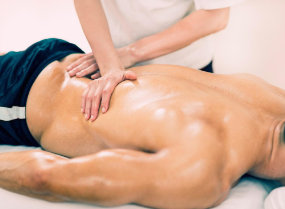
What autoimmune diseases are responsible for severe muscle pain?
Autoimmune diseases occur when the body's immune system mistakenly attacks itself. When the immune system is healthy, it is able to fight bacteria and infections. Let's see which autoimmune diseases cause pain:
• Multiple sclerosis (MS).
• Lupus.
• Inflammatory myopathies such as inclusion body myositis and polymyositis.
What infections cause muscle pain?
Bacterial and viral infections can cause muscle pain throughout the body . Depending on the cause, you may also experience swollen lymph nodes, fever, and nausea. Let's look at the main infections that cause muscle pain :
• Colds and flu.
• Trichinosis (a disease that is transmitted by food).
• Lyme disease and Rocky Mountain spotted fever (these infections are transmitted by tick bites).
• Malaria.
What injuries can cause muscle pain?
Repeatedly using the same muscles at work or during physical exercise can cause pain due to overuse of the muscles. Injuries that cause muscle pain are the following:
• Abdominal sprains.
• Back sprains and strains.
• Tendinitis.
• Tendinosis.
• Bone fractures and traumatic injuries.
• Myofascial pain syndrome due to repetitive movements (overuse).
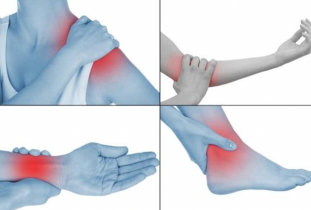 |
| Tendinitis is one of the causes of muscle pain. |
What medicines cause muscle pain in the body?
Certain medications and treatments can cause muscle aches throughout the body and tiredness on a temporary or chronic basis. Some medicines cause muscle inflammation around muscle cells (myositis) or can activate pain receptors. They are the following treatments:
• Cancer treatments, including chemotherapy and radiotherapy.
• Medicines to combat high blood pressure, such as angiotensin-converting enzyme (ACE) inhibitors.
• Medications to lower cholesterol levels (statins).
What neuromuscular disorders cause muscle pain?
Neuromuscular disorders affect the muscles and the nerves that control them. The disorders can cause muscle fatigue and pain. They are the following conditions:
• Amyotrophic lateral sclerosis (ALS or Lou Gehrig's disease).
• Spinal muscular atrophy (SMA).
• Myasthenia gravis.
• Amyloid Gehrig's disease (ALS) or amyloid Gehrig's syndrome (ALS).
Other conditions that cause muscle pain
• Fibromyalgia.
• Cancer, such as sarcoma (soft tissue cancers), and leukemia (blood cancer).
• Chronic Fatigue Syndrome.
• Peripheral arterial disease (PAD).
• Hypothyroidism (underactive thyroid gland).
• Electrolyte imbalances (of minerals in the blood such as calcium, magnesium, sodium and potassium).
• Compartment syndrome (increased muscle pressure).
• Stress and tension.
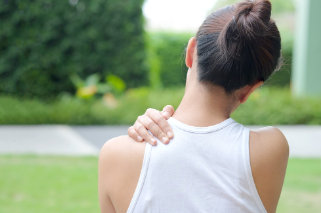
Muscle therapy against pain
Doctors must diagnose your pain in the body. If you do not know the cause of muscle pain, or if the discomfort is severe or chronic, the doctor can perform several tests:
• Blood tests to check your levels of enzymes, hormones and electrolytes. Also, to detect infection
• Obtaining magnetic resonance imaging (MRI) or computed tomography (CT) to look for muscle injuries.
• Biopsy to look for changes in muscle tissue that may indicate a neuromuscular disease.
• Electromyography to measure the electrical activity of nerves and muscles.
Treatments for muscle inflammation and pain
Sometimes, a muscle contracture can only be relieved with physical therapy . However, depending on the cause of the discomfort, the following measures may help you feel better:
• Relaxes and elevates the painful area. For example, if you feel pain in your leg muscle.
• Use ice packs (you can buy them at the pharmacy) to reduce muscle inflammation and also heat to improve circulation.
• Take a warm bath with Epsom salts or a warm shower.
• Take an over-the-counter muscle relaxant (pain reliever) (such as aspirin, acetaminophen, ibuprofen, or naproxen).
• Other therapies that may work for you are muscle massages, meditation or acupuncture.
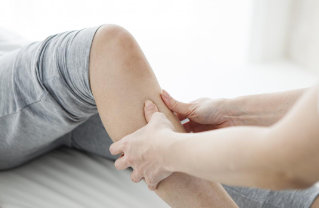
Should I visit the doctor for muscle pain?
Contact your doctor if muscle pain is accompanied by the following symptoms:
• Chest pain.
• You suffer from fever.
• You lose control of your bladder.
• Muscular weakness.
• Numbness or tingling in the extremities.
• New pain appears or the discomfort you already had worsens.
Almost everyone experiences muscle pain from time to time. Short-term discomfort can be relieved with good rest, stretching, and pain relievers. When muscle pain is chronic and intense, it can make it difficult to do the things we like. If a condition is causing you chronic muscle pain, talk to a health professional about treatments to help.
The RICE method for muscle pain
The first muscle therapy that we are going to see is the RICE method . It can help you if you have suffered a muscle contracture in the gym or while doing any other sporting activity (basketball, football, swimming...), or due to a bad gesture or bad posture. RICE is widely used in physiotherapy, although you can easily apply this system at home as a first measure against pain.
RICE is "Rest", "Ice", "Compression" and "Elevation". We will follow the RICE method to treat a sore muscle or area. RICE is a physical therapy that will help you reduce pain and inflammation. In addition, it can also help you heal a sore muscle and regain muscle flexibility.
What to do if a muscle hurts? Follow the four steps of RICE therapy:
1. Rest and protect the injured or painful area.
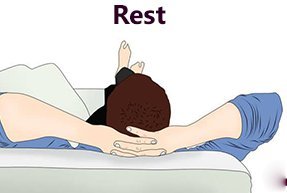
2. Ice . You should apply ice or cold packs to the area as soon as possible.
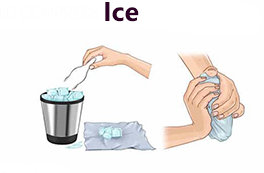
3. Compression . You should place a wrap around the injured or painful area using an elastic bandage.
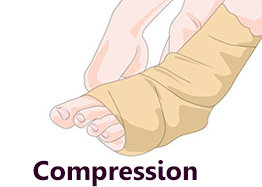
4. Elevate (providing support) the injured or painful area.
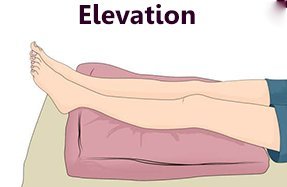
Learn to put the RICE method of physiotherapy into practice .
When to apply RICE?
Do this as soon as possible after suffering an injury, such as a sprained knee or ankle. You can reduce pain and swelling and promote healing and flexibility using RICE: Rest, Ice, Compression and Elevation . Let's look at the four steps in much more detail.
Rest
Rest and protect the injured or painful area. If an activity causes you pain, stop it or change it. Take a break from any activity that may cause pain or discomfort.
Ice
Apply ice or cold compresses immediately to prevent or reduce muscle inflammation. The cold will reduce pain and swelling. Apply ice or cold packs for 10 to 20 minutes 3 or more times a day. If you see the swelling disappearing after 48 to 72 hours, warm the painful area. Do not apply ice or heat directly to the skin. You must place a towel over the hot or cold compress before applying it to the skin. Also apply ice after prolonged activity or vigorous exercise.
Compression
Wrap the injured or sore area with a flexible bandage (such as an Ace bandage) to reduce swelling. Don't put the bandage on too tightly, as this can increase swelling under the damaged area. Remove the bandage if it is too tight. Signs that the bandage is too tight are numbness, tingling, increased pain, feeling cold, or swelling in the area under the bandage. Contact your doctor if muscle pain lasts more than 48-72 hours because then we are talking about a more serious problem.
Elevation
You have to elevate the injured area on pillows using ice and every time you sit or lie down. Try to keep the area at or above heart level to reduce swelling.
What can I use RICE Rest Ice Compression and elevation for?
• Ankle sprain.
• Knee sprain.
• Sprained wrist.
• Patellar tendonitis.
• Achilles tendinitis.
• Wrist tendonitis.
• Treatment of muscle injuries: arm, shoulder, forearm, hamstrings, quadriceps...
The RICE method is cryotherapy (an ice treatment). You can apply RICE physiotherapy therapy on a sprain, muscle injuries, stiffness and contractures. The system is so easy that you can put it into practice at home.
What exercises for muscle pain can I do?
The best exercises for muscle and joint pain are some simple stretches that you can do before and after doing physical activity. The exercises we propose will help you combat muscle pain and prevent injuries.
Acute muscle pain can occur after exercise, after making a sudden movement, or having a bad night's sleep. If you feel like you can't move, this means you have suffered a muscle contracture . We propose some simple stretches and movements that can help you.
Do you know why you feel pain in your muscles? Perhaps you have ever heard that severe muscle pain is caused by the buildup of lactic acid in the muscles. Lactic acid would be responsible for causing muscle soreness and cramps. However, certain studies suggest that severe muscle pain is due to inflammation of muscle cells.
There is a condition called delayed onset muscle soreness (DOMPAT), which occurs after exercise. This is a natural response of the body to repair the damage caused during physical activity that we do not usually do regularly. You don't have to worry about this hassle; They are just microscopic injuries that are part of a normal body recovery process.
Muscle inflammation may persist even for several days after exercise (up to three days later), but it will gradually subside. Believe it or not, not only beginner athletes experience DOMPAT, but also experienced athletes.
Muscle pain indicates that a specific area of the body is experiencing stress. Pain is an absolutely essential signal! Have you heard they say “if it hurts it's because the area is working”? This couldn't be more true. So when your muscles ache a little after exercise, be glad. It means that your body is recovering from the effort you have made.
When muscle pain prevents us from moving fluidly, we must do something about it. We have to help our body reduce pain symptoms. Let's look at gentle exercises for muscle pain .
Stretch the hips and back
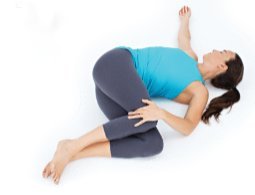
Our spine suffers a lot when we exercise or lift too much weight. If your ribs or lower back hurt, this move will be helpful. You can use a gymnastics mat.
Steps to follow:
- Lie on your back with your arms at your sides. Your knees must remain bent side by side and your feet flat on the floor.
- Turn your hips to the right without lifting your shoulders off the mat until your knees touch the floor.
- Hold for a few seconds and then do it with the other side (bringing the hip to the left).
The half Moon
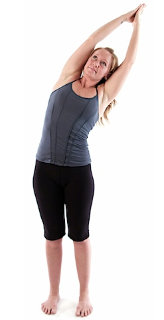
This posture is yoga. It's a pretty good move to stretch your upper muscles.
Steps to follow:
- Stand with your feet together.
- Raise your hands above your head touching your palms. She tries to keep her arms straight.
- Lean your body to the right, come back to the center, and then lean your body to the left. Repeat this several times.
"Cat" pose
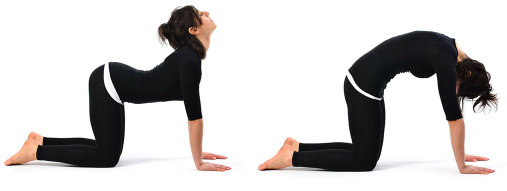
Here is another exercise that helps you stretch your back and reduce severe muscle pain. It consists of placing the hands, knees and feet on the ground.
Steps to follow:
- You have to do the movement with your back: first you have to arch down and then up. Engage your head to fully stretch your body.
"Butterfly" stretch
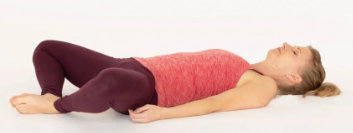
Sit on the floor or a mat to do this exercise for sore muscles.
Steps to follow:
- Cross your legs so that your knees are "out" and the soles of your feet are together.
- Bring your back back and, very slowly, lie down on the floor.
- Your legs will open slightly and push your knees down.
Cobra stretch
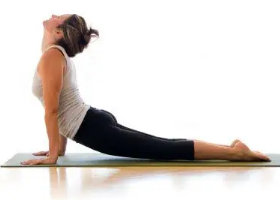
After doing a few sets of crunches, your muscles will be very sore, especially if the sets were very long or if you haven't trained in a long time.
Steps to follow:
- Lie face down on the mat and place your hands at shoulder height. Inhale and lift your torso. Place your head slightly back.
- We look for the torso to be stretched, the shoulders away from the ears and the hip resting on the ground.
- As you exhale, lower your forehead until it touches the ground.
"Mountain" Stretch
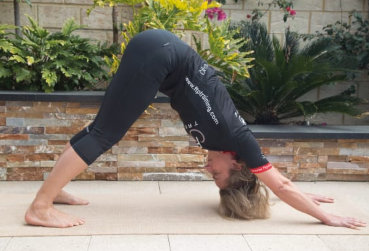
We will take the same position as in the previous exercise.
Steps to follow:
- Raise the hips so that the body forms a kind of triangle.
- Your shoulders, arms and head will not come off the ground nor will your feet.
- Hold the position for a few seconds. Then, rest, return to the starting position and repeat again (do 10 repetitions).
Bring your legs to your chest
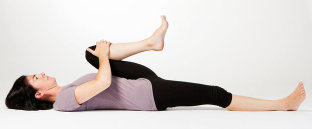
One of the places that hurts the most from exercise or daily movement is the back. We can stretch our back in different ways without the activity becoming a nightmare.
Steps to follow:
- Lie on your back on the mat and rest the soles of your feet on the ground.
- Bring your right knee up to your chest and hold it with your hands (as if you were wrapping it).
- Press your knee slightly towards you and return to the starting position to switch to the left leg.
- After completing a set of 10 repetitions, do the same, but lift both legs at the same time.
- If you wish, you can make a small pendulum movement to one side and the other.
Keep in mind these simple exercises for muscle pain . You can try the exercises to relieve the following problems and areas of the body:
• Muscle and joint pain throughout the body.
• Contracture (treatment).
• Muscle contracture in the shoulder.
• High back.
• Middle back.
• Lumbar area (right and left) or lumbar spine.
• Contracture in the trapezius.
• Muscle pain in both arms.
• Muscle pain in the hip.
• On the chest.
What to do if I feel pain in my leg muscles?
After suffering from muscle problems in your legs , it is important to regain movement and strength. This will encourage tissue healing and help you move again. You may not be able to return to your usual level of exercise right away. Recovery may begin slowly. However, a gradual return to normal activity is the best way to achieve good short- and long-term results after a thigh problem.
When you exercise, you need to pay attention to your pain level, especially in the early stages. Exercise may make your symptoms a little worse at first. However, over time, the symptoms should decrease. Regular exercise for muscle pain could help improve thigh mobility.
If the exercises cause you any discomfort, a powerful natural muscle relaxer from the drugstore can help you continue. However, your GP or pharmacist will have to prescribe it for you.
Let's look at some exercises for thigh muscle pain that are suitable for most people.
- Make sure you do the exercises in a safe environment. Try the exercises only if you feel comfortable enough.
- If you start to feel bad, stop exercising immediately.
- If you are trying the following exercises for the first time, please read the information we provide below before you begin.
Tip : For each exercise, hold onto something sturdy, like a heavy chair or the kitchen counter.
Leg extension while lying on the ground
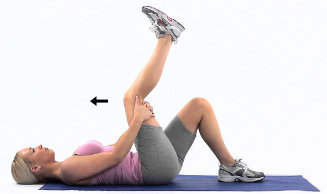
Make sure you hold onto something sturdy, like a heavy chair or kitchen counter. A stretch is one repetition.
Steps to follow:
- To stretch the back of the thigh, lie on your back and lift one leg up towards your chest.
- Place your hands behind your knees.
- Gently pull the leg towards the chest; you should feel a stretch in the back of your thigh.
- Hold the stretch for up to 10 seconds and then lower your leg toward the bed or floor.
Bend your knees while lying on the floor

The movement consists of bending and straightening the knee. This is a repeat.
Steps to follow:
- Sit on a sofa or bed with your legs supported. Bend your knee as much as you are comfortable. You can spread your hands slightly to facilitate movement.
- Hold this position for 2 seconds before returning to the starting position. Then, do the same with the other knee. Alternate them!
Standing Quadriceps Stretch
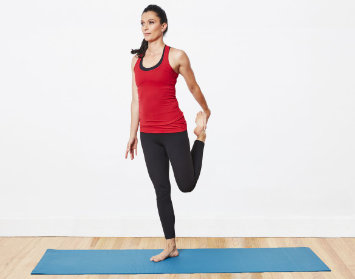
It involves lifting and bending the knee on each repetition.
Steps to follow:
- Stand up and hold on to something with one hand.
- Raise and bend the knee by pulling the ankle towards the gluteus; you should feel a stretch in the front of your thigh.
- Try to hold the position gradually for longer and longer. For example, 20 or 30 seconds for the best benefit.
Full standing hamstring stretch
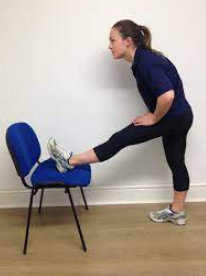
Bending and straightening the knee is one repetition.
Steps to follow:
- Stand up and stretch one leg in front of you. Rest your heel on a chair for a better stretch. Bend your other leg slightly to feel a stretch in the back of the thigh. Hold in this position for several seconds.
- Gently pull your leg towards the floor.
- Try to increase the stretching time gradually up to 20 or 30 seconds for the best result.
What to do if I feel pain in my neck muscles?
Medical follow-up is key to treatment and safety if you feel pain. Schedule and keep all appointments with your doctor if you have neck muscle problems . The doctor will analyze your test results and review the medications you are taking to see if they could be causing pain.
What can you do at home? If you have neck pain , here are some examples of exercises you can try. These exercises may be recommended if you have a medical problem or need rehabilitation . Start each exercise slowly. Reduce the amount of exercises if you start to feel pain.
Neck rotations

- Sit on a sturdy chair or stand up straight.
- Keeping your chin straight, turn your head to the right and hold it there for 15 to 30 seconds.
- Turn your head to the left and hold it there for 15 to 30 seconds.
- Repeat 2-4 times on each side.
Neck stretch

- Look forward and place your right ear against your right shoulder. Don't let your left shoulder rise as you turn your head to the right.
- Hold for 15-30 seconds.
- Tilt your head to the left. Don't let your right shoulder rise when you tilt your head to the left.
- Hold for 15-30 seconds.
- Repeat 2-4 times on each side.
Lean neck forward
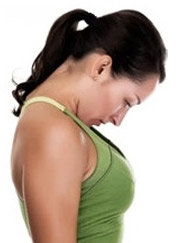
- Sit on a sturdy chair or stand up straight.
- Tilt your head forward.
- Hold the position for 15 to 30 seconds.
- Repeat 2-4 times.
Lateral flexion with effort
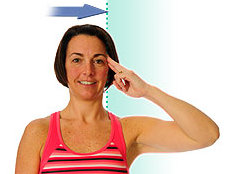
- With your right hand, place the first two fingers on your right temple.
- Begin to tilt your head to one side while gently applying pressure with your fingers to prevent your head from flexing.
- Hold the position for about 6 seconds.
- Repeat 8 to 12 times.
- Then, change hands and repeat this exercise with the left side.
Forward bending with effort
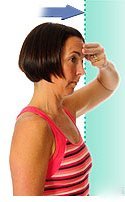
- Place the first two fingers of each hand on your forehead.
- Begin to bend your head forward while gently pressing with your fingers to prevent your head from bending.
- Hold the position for about 6 seconds.
- Repeat 8 to 12 times.
Effort from neutral position
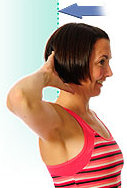
- With one hand, place your fingertips on the back of your head, at the top of your neck.
- Try to tilt your head back while pressing gently with your fingers to prevent your head from bending.
- Hold for about 6 seconds.
- Repeat 8 to 12 times.
Chin flexion
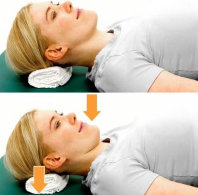
- Lie down on the floor placing a rolled towel under your neck. Your head should touch the floor.
- Slowly move your chin towards your chest.
- Hold the position for 6 seconds and then rest for up to 10 seconds.
- Repeat 8 to 12 times.
Combat neck and shoulder muscle pain with the proposed activities.
How do you know if you are doing the exercise at the correct level?
The following guide will help you know if you are training at the right level. It will also help you see how much pain or discomfort you can tolerate. It may be helpful to rate your pain, for example, on a scale of 10 (0 means no pain; 10 is the worst pain you have ever experienced):
• 0-3 is low pain.
• 4 to 5 is tolerable pain.
• 6-10 is excessive pain
Try to keep the pain between 0 and 5 . If the pain exceeds this level, you can modify the exercise as follows.
- Reduce the number of times you make a move.
- Reduces movement speed.
- Increase rest periods between movements.
Muscle pain after exercising
Exercise should not in any way aggravate existing thigh pain. However, doing new exercises can sometimes cause temporary muscle soreness as the body gets used to moving in a new way. This pain should disappear quickly and should not worsen the next morning after exercise.
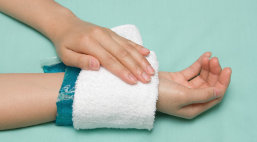
Frequency of exercises
You should gradually incorporate exercise into your routine to reduce muscle soreness.
For exercises with movement
Reps tell you how often you do a movement. When starting new exercises, you may find it helpful to do 2 to 3 repetitions at a time. It is best to do the exercise in small amounts throughout the day. Practice repetitions, for example, every hour.
As it gets easier and you feel capable, add 1 or 2 repetitions to the movements every few days. When you can do more repetitions, you may find it helpful to divide the movements into sets. This means you can do more reps at the same time, but less frequently throughout the day. Let's look at an example:
- Do 8 repetitions.
- Rest a minute.
- Do another set of 8 repetitions.
- Repeat this 2-3 times a day.
You can try increasing the number of repetitions over time. You should try to do a maximum of 2 sets of 15 reps .
For muscle stretching exercises
The goal of muscle stretching is to maintain a posture for longer. Over time, this can help you improve your range of motion. When performing the exercise, you should feel a slight stretch. It shouldn't be painful or uncomfortable.
If possible, try to hold the stretch for 20 to 30 seconds . Try to concentrate on performing the sets of exercises. For example, do 2 or 3 sets of stretches. Try to do them 2-3 times a day . As you do more stretches, you should feel your range of motion improve and you will be able to stretch longer.
When should I stop the exercises?
Stop doing these exercises if they worsen your symptoms or cause new pain. If your muscle pain worsens after following the proposed activities, it is recommended that you discuss your symptoms with a health professional.
Here are some self-care solutions for muscle problems. However, if your pain has not improved within 6 weeks of following our advice, we recommend that you contact a healthcare professional about your symptoms.
Your muscle pain therapy should start with the RICE method and continue with exercises for each specific part. Lucky for you, we've listed exercises for muscle pain in your torso, back, thighs, and neck. You can save these exercises in PDF to consult them whenever you need it.









